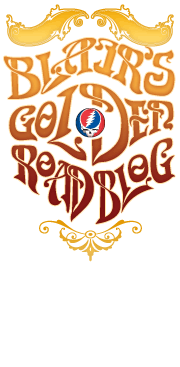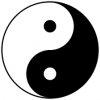Yeah, yeah, I know. We’re all supposed to be somber as we approach 9/11.
But I’m more interested in celebrating 9/11—specifically 9/11/81—the 30th anniversary of the Dead’s first (modern) appearance at Berkeley’s Greek Theatre. That evening was the first of 27 shows the band played at that magnificent venue from 1981-1989 (three per year). If you ever got to experience a Dead show there, you know there was nothing else quite like it.
I had already enjoyed many concerts at the Greek before I caught the Dead there. When I moved to Berkeley in the fall of ’73, the Greek was my neighborhood venue — for three years I lived a few blocks south, down Piedmont Avenue on Frat Row (but not in fraternities), a five-minute walk to the Greek. Racking my memory, I came up with a slew of great shows I attended at the Greek before September ’81, including Linda Ronstadt in her prime (’75), Jefferson Starship (’75), Bob Marley & the Wailers (’78), Joni Mitchell and Herbie Hancock at the Bread & Roses Festival (’78), the amazingly psychedelic “Tribal Stomp” of ’78 (featuring the Paul Butterfield Blues Band, Country Joe & the Fish, Big Brother), Weather Report (’79), Bonnie Raitt (’80), Neil Young’s Hawks and Doves tour (’80) and The Kinks with killer opener Joe Ely (’81). So I knew that magic was easily accessible there. No wonder I was positively salivating at the prospect of seeing the Dead play there for the first time since a sparsely attended benefit concert in 1967.
It had been a while since I’d seen the band. I missed the ’80-’81 New Year’s series at the Oakland Auditorium because I was visiting family back East and getting engaged to my beautiful wife on New Year’s Eve, above Times Square. And the Dead didn’t play a show in Northern California the eight months before the Greek concerts, so my last show had been the final night of the Warfield 15th anniversary run (10/14/80). As fate would have it, the ’81 Greek series was the first three-show run Regan and I ever attended and it came just a month and a half after our wedding (also in Berkeley). Incredibly, the Dead had not played an outdoor show in the Bay Area since their Oakland Stadium (ugh!) concerts with The Who back in 1976.
When we arrived at the Greek that Friday, Sept. 11, we found the old place had been fabulously decorated by the good folks at Bill Graham Presents. A gorgeous, trippy tie-dye backdrop created by Courtenay Pollack (he of the fabulous GD tie-dyed amps of the early ’70s) spanned the entire width of the normally drab, grey concrete stage from the floor to about 10 feet above the musicians’ heads. The lower part of the tie-dye consisted of circular mandala designs in blues, greens, purples and yellow; topped by more mandala patterns that were connected by a striking yellow-dominated serpentine shape that seemed to undulate constantly; a psychedelic snake guarding the stage! Above that, between the two center columns at the rear of the shallow stage, were the friendly cutout male and female skeletons that had graced the front of the Warfield a year before for that 15-night run, and in each of the spaces between the other columns at the rear of the stage were huge wreaths of roses and other flowers.

The tradition established that first year at the Greek was the Friday show would start at 7, the Saturday show at 5 and the Sunday one at 3. As we quickly learned, this gave each show a different visual character, with the first mostly in the dark, the second split between daylight and evening, the third between afternoon and dusk. Nights could be bitterly cold if the famous Bay Area fog came whipping through the Golden Gate, crossed San Francisco Bay and reached up into Berkeley with its wispy fingers. But Saturday and Sunday afternoons were frequently quite warm, the shadeless concrete bowl radiating heat.
The setting was stunning—the 9,000 capacity venue, built in 1903, was modeled after ancient Greek amphitheaters, with the main stepped bowl (and a shallow, steep grass lawn with a canopy of towering eucalyptus trees above it) accommodating perhaps two-thirds of the crowd, who spread blankets out and danced or put down cushions and sat, or both; it was very loose and free-form, particularly the first couple of years. The rest of the audience was gathered in a semi-circle between the stage and the raised bowl, mostly dancing. It was usually fairly crowded up below the stage, as you’d expect, but nothing compared to a packed arena or stadium. There was also a rim of slightly elevated marble “thrones” at the back of the main floor—never sat in one myself, but they were always in high demand.
What made the Greek so special—aside from the clear and powerful sound (ask any musician who’s played there)—was that the bowl configuration allowed us all to enjoy each other in a way that a conventional venue, where all the seats are facing forward, oriented toward the stage, could not. Your eye was naturally drawn to the rhythmic sea of dancing bodies all around the bowl. You’d see friends and acquaintances from afar, maybe share a moment or two, before your attention might shift back to the stage or the tie-dye backdrop or, once night fell, the splashes of colored lights the ever-inventive Candace Brightman would project on the crowd. In the late afternoon sun, you’d see bronzed bodies glowing in the golden light, the sun’s reflection in thousands of sunglasses around the bowl.
That first Sunday Greek show in ’81, there was a small group of long-tressed, nubile young women who danced topless for much of the afternoon—a California dream come to life as the band played on. People picnicked before the shows and at the break, visited friends, walked to the top of the bowl to take in the panoramic view of the Golden Gate Bridge across the bay (fog permitting). Frisbees—supposedly banned—sailed across the expanse of the amphitheater, eliciting “oohs” and “aahs,” or sat in laps to be used for rolling joints. In later years, the scene outside the shows got kind of crazy—and eventually led to the Dead being banned from the venue—but inside it often felt like being in an enveloping rainbow-hued cocoon. Everything you needed and everyone you wanted to hang with was right there.
The bonus to an afternoon and evening livin’ the good life at the Greek was that a Grateful Dead concert was part of the deal, too. And more often than not the band played really well there. This past week I’ve been under headphones revisiting the ’81 Greeks courtesy of some fine audience recordings I downloaded to my iPod Nano from Archive.org. (Sad to say, soundboards of those shows do not seem to exist, diminishing the likelihood that we’ll ever see a Complete Greek box someday.) I hadn’t heard the shows in years, and they certainly lived up to my rosy memory of them. They’re filled with energetic and enthusiastic playing, there are a few ferocious jams, and nearly all the big songs and combos deliver—“Scarlet” > “Fire,” “China Cat” > “Rider,” “Estimated” > “Eyes” (all from the spectacular Saturday show), “The Other One,” “Morning Dew,” “Bird Song,” “Stranger” > “Franklin’s”; the hits keep a comin’ one after another.
I’m not saying they were the best shows of all time or anything, but the overall experience of the three days—the setting, the music, the crowd—was so overwhelmingly positive, even transcendent, my appreciation of the whole scene soared to another level. And I thought I was already hard-core!
I could fill a book just talking about all the Dead’s Greek Theatre shows through the years—Courtenay’s tie-dyes in ’82 and ’83; a “Morning Dew” that literally knocked me off my feet; the ’84 “Dark Star” encore; the 20th anniversary shows; the fabric hot-air balloons festooned with rose designs that were launched from backstage one year; the “motorcycle space”; Flora and Airto helping out the Rhythm Devils; Bob’s hilarious band introductions during the ’86 “Good Lovin’”; the intergalactic “Other One” of ’89; and on and on.
Back on Sept. 11, 1981, when we were standing there, dazed and delighted at the end of that first night, we had no idea what the Greek would come to mean to us all. Or that the next year would bring us the first shows at Frost Amphitheatre across the bay, and Ventura down the coast, the Downs in Santa Fe and so many other beautiful places that made being a Dead Head in the 1980s so special. The Greek ’81 was the start of all that.
Oh, yes: Sept. 11 is also Mickey Hart’s birthday; has been for the past 68 years!
Care to share some Greek memories with us?
(To see more of Clayton Call’s cool photos of the Dead and other bands, click here.)






